Worldpay: The Future of Electric Vehicle Charging Payments
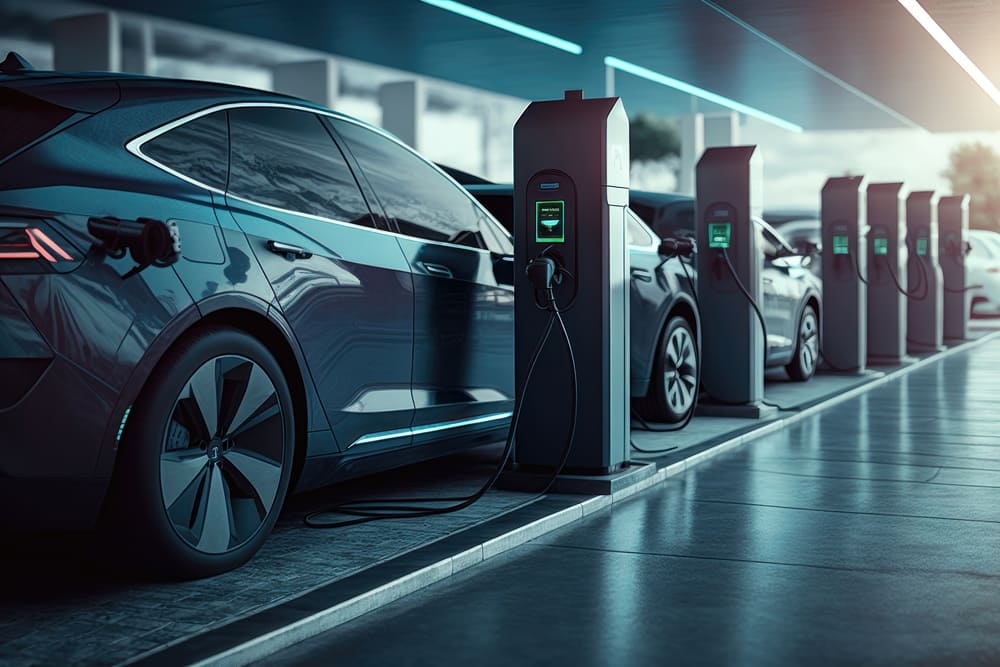
Accelerating Growth
The mounting global environmental crisis is prompting the world to analyze industries through a heightened lens of sustainability.
This is especially true for the automotive sector which, although historically high-polluting, has now nominated itself as a flagship for change. In particular, electric vehicles (EV), and subsequently electric vehicle charging (EVC), are paving the way forward in this space.
In 2021, EV sales represented nearly 9% of car sales globally1. This is projected to increase to 20% by 2025 and 59% by 2035. This rapid expansion has caused a boom in EVC infrastructure, where the global market was worth $26bn in 2022 and is predicted to reach an astonishing $222bn by 20302.
So, what’s driving this growth?
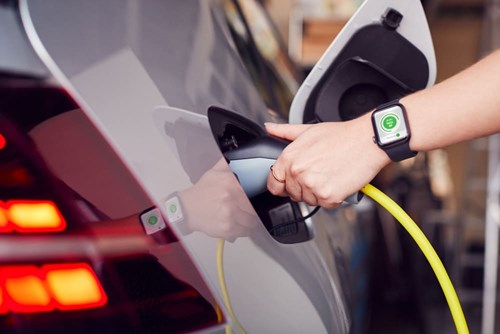 One key factor is legislation boosting the adoption of electric vehicles across the globe. For example, several North American states and EU member countries have agreed to ban the sale of new fossil fuel vehicles by 20353. Furthermore, various governmental bodies have enacted incentive schemes for consumers who are making the switch to EVs, helping to increase uptake further. To deal with the rise in EV numbers, the US government has promised to implement 500,000 EV chargers before 20304. Additionally, the European Federation for Transport and Environment predicts there will be 10 million EVC stations across Europe by 20355.
One key factor is legislation boosting the adoption of electric vehicles across the globe. For example, several North American states and EU member countries have agreed to ban the sale of new fossil fuel vehicles by 20353. Furthermore, various governmental bodies have enacted incentive schemes for consumers who are making the switch to EVs, helping to increase uptake further. To deal with the rise in EV numbers, the US government has promised to implement 500,000 EV chargers before 20304. Additionally, the European Federation for Transport and Environment predicts there will be 10 million EVC stations across Europe by 20355.
Another driving force behind the surge is the industry’s constant push for innovation. EV's disruptive technology is built on a foundation of customer-centricity, and providers are constantly pushing the boundaries to create a more seamless experience for their consumers. Concerns, such as long charging times and unreliable infrastructure, are being actively addressed and improved upon, which also helps to eliminate any lingering doubts that prospective customers may have.
With rapid expansion across the globe and a heightened focus on the customer, a payment experience that is not only efficient but allows customers to pay in their preferred way should be something that EVC providers take into consideration.
The Power of Convenience
With the touch of a button, modern consumers are able to accomplish most things in their day-to-day lives.
The EVC industry must seamlessly integrate into the customer's lifestyle to keep up with this level of convenience. This includes understanding preferred payment methods and habits. Data published by The Department for Transport shows that inconsistency in the way consumers pay for charging is actually creating a barrier to EV adoption and public charging6. As payment systems evolve, features like contactless payment are no longer just preferable - they are expected.
As the EVC industry grows, so does the number of suppliers and consequently, the number of corresponding apps. However, it's understandable that consumers don't want to deal with multiple apps when paying for their charging needs. As a result, a number of aggregators have emerged, providing a range of benefits such as optimal route planning, locating the nearest EVC stations, and offering a single platform for payment. By streamlining the payment process, consumers can more easily access and pay for the charging services they need using their preferred payment method. To provide the level of convenience that customers are looking for, EVC providers must collaborate or offer the same level of payment experience as these aggregators.
In addition to the growing demand for convenience among consumers, there are also new laws emerging that require EVC providers to offer specific payment options. These regulations are already being implemented in Europe, with plans underway to mandate the installation of card-present payment terminals at all EV charging stations that exceed 50kWh.
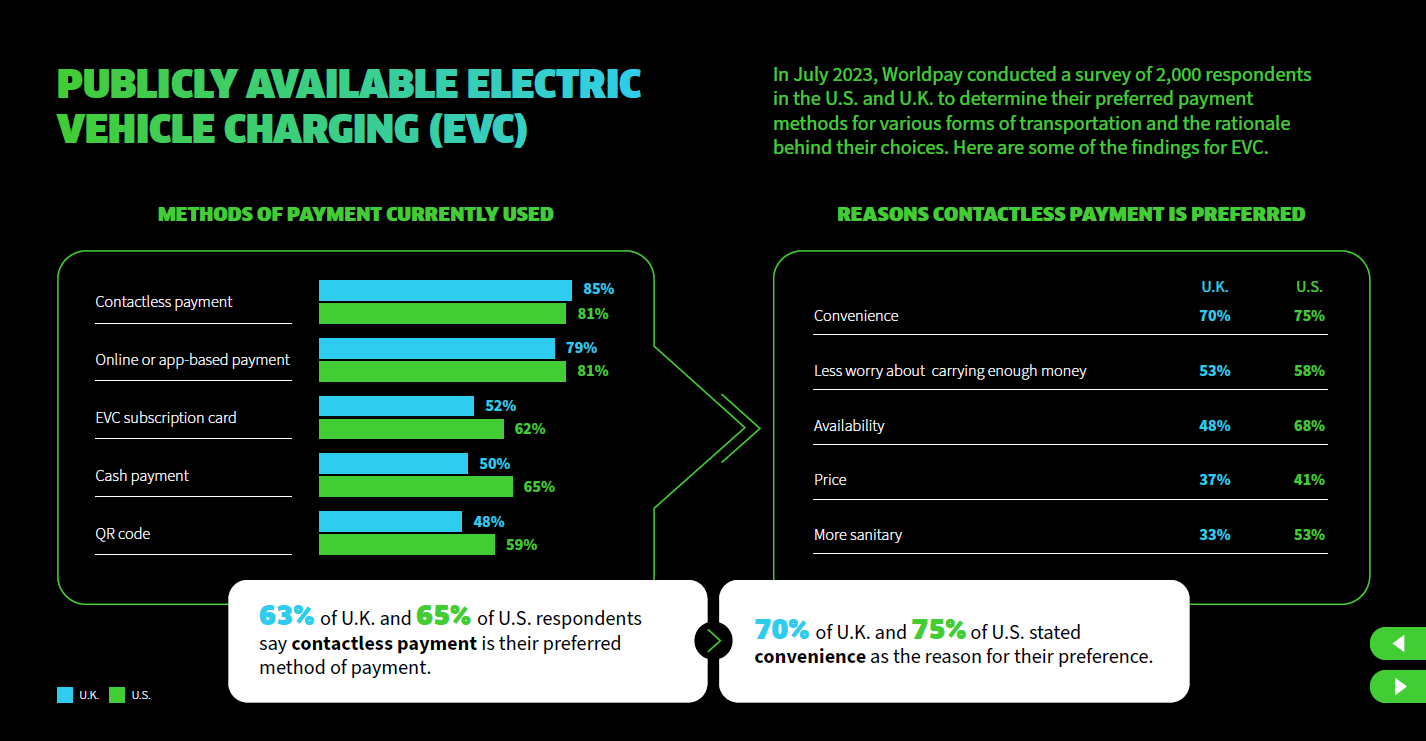
How to Ensure a Best-In-Class Payment Strategy:
Consider payment preferences
The way customers want to pay varies across the globe. Knowing your consumer payment preferences can lead to increased satisfaction, loyalty, and ultimately, revenue for your business. By offering a wide range of payment options, providers can increase their chances of attracting - and keeping – more customers.
Optimize your payment strategy
The cost of payments can account for 1-4% of revenue for an EVC company. In the fiercely competitive EVC landscape, optimizing payment flows could have a substantial impact on your bottom line, giving providers an edge by allowing for reinvestment in customer-centric areas. This two-fold benefit could improve customer experience, ultimately leading to more revenue.
Prioritize convenience
To keep up with the convenience modern consumers expect, the EVC industry must seamlessly integrate into their lifestyle by understanding preferred payment methods and habits. With the rise of aggregators in the EVC space, providers must collaborate or offer the same level of payment experience to meet customer needs.
Innovate
In today's competitive market, staying ahead of the curve requires innovation. One solution to consider is offering QR code payments to customers. By scanning a code, users can access a payment page directly without the need to download charging apps. This not only creates a seamless experience for users but can also help providers reduce the costs associated with physical payment infrastructure.
Global reach
As the demand for electric vehicles rises, it is important for EVC companies to expand their operations beyond just one region or country if they want to succeed in this increasingly competitive environment. Payments play a crucial role in this expansion. By offering payment options that cater to the specific needs and preferences of different regions, providers can increase their customer base and gain a competitive edge.
Create loyalty
The way customers want to pay varies across the globe. Knowing your consumer payment preferences can lead to increased satisfaction, loyalty, and ultimately, revenue for your business. By offering a wide range of payment options, providers can increase their chances of attracting - and keeping – more customers.
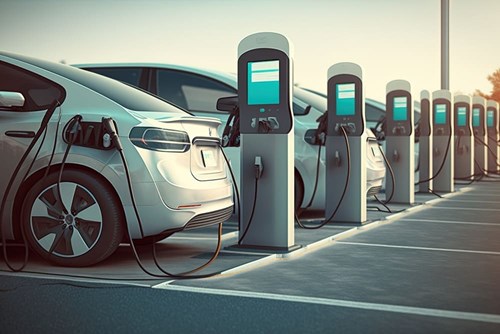
Navigating the Road to the Future
Given the evolution of payment methods and preferences to date, coupled with the inherently innovative nature of the EV industry, it is safe to assume that the future landscape of EVC payments will be significantly different from what we currently know.
Our team of strategic experts has identified three key trends that we believe will have a profound impact on shaping the EVC industry in the years to come.
1. Making the most of charge times
As the market for electric vehicles continues to grow, providers are working hard to match the charging times of EVs with those of ICE (internal combustion engine) vehicles, however, it's unlikely that a mass, affordable solution will be rolled out anytime soon. One promising strategy to overcome this limitation is to integrate EVC with complementary retail and hospitality services.
Some providers have already partnered with supermarket businesses, such as Pod Point and Tesco, but there is still a great opportunity to take these relationships further. For instance, charging companies could offer loyalty and point schemes to establishments located near their stations, which would bring in more business for both parties. Additionally, EVC stations could expand their functionality to include food ordering from partner establishments, enhancing the customer experience further.
With basic charging stations moving towards smarter charging hubs, the possibilities to enhance the customer experience are endless. These innovations could be made even easier with the introduction of in-car payments, where a consumer's vehicle has its own mobile payment capability.
2. The rise of Plug-and-Charge
Plug & Charge is a simple and secure method for drivers to charge their electric vehicles. Unlike other charging methods, there's no need to pay with credit cards or download a mobile app - drivers can simply connect their EV's charging cable to the charge point and the vehicle will start charging immediately without any additional steps needed.
The entire process is safe and confidential, with identification and authorization conducted via a highly secure communication link. Each vehicle is associated with a unique billing account, and the energy supplied to the EV is recorded and transacted for a seamless charging experience. The benefit is twofold; not only does Plug &Charge create the ultimate level of convenience for the customer but also streamlines operations for EVC providers.
3. Growing adoption of subscription services
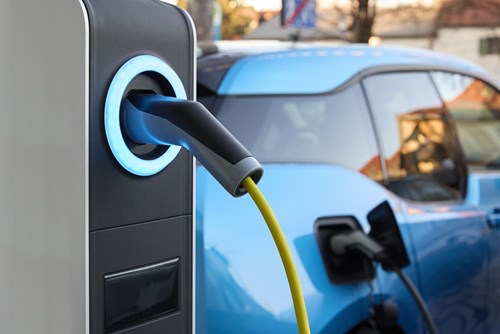
Although subscription services have been present in the EVC industry since its inception, it is expected that more consumers will adopt this service going forward. Providers are anticipated to offer more comprehensive packages that include a specific number of miles for a fixed monthly rate, with reduced prices for any additional charging. These subscription services also have an opportunity for providers to offer loyalty programs, which are crucial for customer retention.
Tokenization is the process of replacing sensitive payment information, such as credit card numbers, with a unique identifier known as a token. These tokens can be securely stored and used to enable “one-click” payments for future transactions, making this an excellent fit for businesses that have subscription-based models or rely heavily on repeat customers. Customers benefit from only having to provide their payment data once, giving them maximum convenience as well as data security.
Blockers to Growth
The electric vehicle industry is growing at speed, but this doesn’t imply that the road ahead will be smooth.
With the remarkable surge in EV sales, it's essential to ask whether the EVC industry can keep pace. To ensure success, it's important to take a closer look at the main challenges that may lie ahead.
Lack of infrastructure
To meet the demands of the rapidly expanding EV market, the number of EV chargers will need to increase fourfold by 2025, even when taking into account the availability of home charging options7. The supply of EV chargers is currently falling behind the pace of EV adoption. This gap between supply and demand may cause consumer uncertainty, potentially hindering the adoption of EVs.
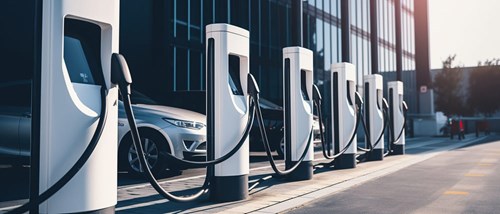
Space for chargers in cities
Another pressing issue is the limited space available for EV charging infrastructure in densely populated areas. The installation of each charger requires a designated parking spot, but with the ever-increasing demand for EV charging stations, it has become clear that there simply isn't enough room in many residential and urban areas to add more parking. This presents a major challenge in meeting the demand for EV charging infrastructure and highlights the need for creative solutions to address this issue.

Infrastructure maintenance
Charge point maps, such as Zap Map, reveal an alarming number of out-of-service chargers. This creates a level of uncertainty among consumers regarding the availability of charging stations and ultimately hinders the adoption of electric vehicles. Although maintenance can be costly, EVC providers need to address this issue if they want to eliminate any further doubts from prospective customers.
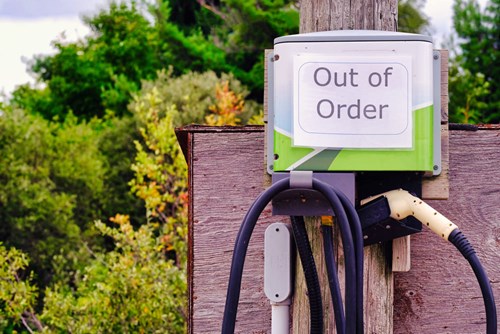
Uncertainty in charging price
In recent years, there has been a considerable rise in the cost of living worldwide due to geopolitical developments and the lasting effects of the global pandemic. Once a major benefit of EVC over petrol and diesel fuels, electricity prices are now volatile and have a direct effect on EVC customers. This instability in EVC pricing could lead to a decrease in demand until a more consistent pricing system is established.

Key Takeaways
Accelerated by advancements in technology and new legislation across the globe, the EVC industry is poised for substantial growth over the next decade. However, the future landscape of EVC payments will be significantly different from what we currently know, with trends such as Plug-and-Charge and subscription services on the rise.
As this growth continues, EVC providers will need to keep up with the pace of demand and navigate obstacles, such as managing rising costs and eliminating consumer uncertainties. By collaborating with other industry players to offer complementary services and prioritizing customer-centricity, businesses can have an edge over the fierce competition. Equally important is the need to provide a payment experience that fits seamlessly into customers' lifestyles and caters to nuanced payment preferences around the world. By doing so, businesses can create loyal customers and drive more revenue.
With over 30+ years of experience in the payments industry, Worldpay proudly serves 1 million+ merchants across 225 markets. Our payments network makes us the perfect partner for your business to expand across new destinations. We offer a unique consultative approach to payments, taking the time to understand your business and payment challenges. Get in touch with one of our experts to see how we can support your payment needs.
Payments 2025 is a thought leadership campaign launched by Worldpay from FIS to highlight the key trends shaping the future of payments. Using our many years of experience and leveraging our vast network of specialists from across the payments industry and beyond, we will share expert opinions and recommendations as well as explore the social, economic, technological and environmental factors that will inform the future and help our merchants to prepare for tomorrow.
Footnotes
1Electric vehicles - IEA
2BCG EV forecast: majority of sales will be electric by 2035 - Protocol
3The countries phasing out internal combustion engines (techxplore.com)
4The US Doesn’t Have Enough EV Charging Stations – BRINK – Conversations and Insights on Global Business (brinknews.com)
5Public charging won’t block higher electric car targets (transportenvironment.org)
6Improvement in EV charging network, costs and payment methods needed | Electric fleet news 5
7EV Chargers: How many do we need? (prnewswire.com)
About Worldpay
Worldpay payment processing solutions allow businesses to take, make and manage payments in-person and online from anywhere in the world. Worldpay solutions, which supports approximately 225 markets in 146 countries and in nearly 135 local currencies, are offered by FIS, a leading provider of technology solutions for merchants, banks and capital markets firms globally. FIS is a Fortune 500® company and is a member of Standard & Poor’s 500® Index. To learn more, visit www.fisglobal.com/en/merchant-solutions-worldpay. Follow Worldpay on Facebook, LinkedIn and X, formerly Twitter (@Worldpay_Global).

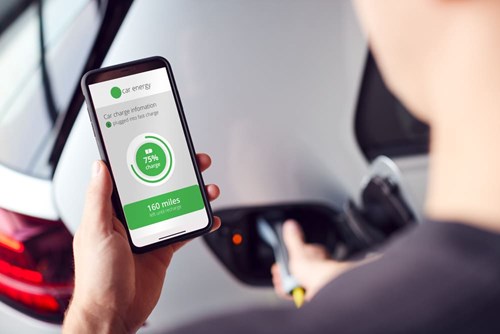

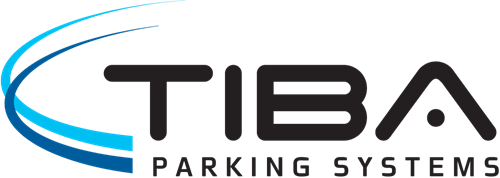


Comments
There are no comments yet for this item
Join the discussion